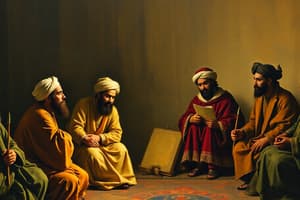Podcast
Questions and Answers
What was the role of education in the rapid spread of Islam, according to the passage?
What was the role of education in the rapid spread of Islam, according to the passage?
What architectural elements are mentioned in the passage as being developed during the early Islamic period?
What architectural elements are mentioned in the passage as being developed during the early Islamic period?
What happened in Medina after Muhammad migrated there?
What happened in Medina after Muhammad migrated there?
What was the significance of the first revealed word of the Quran, according to the passage?
What was the significance of the first revealed word of the Quran, according to the passage?
Signup and view all the answers
What era followed the death of the Prophet Muhammad, according to the passage?
What era followed the death of the Prophet Muhammad, according to the passage?
Signup and view all the answers
Study Notes
Islamic History
Islam has a rich and complex history that spans over a millennium. The religion originated in the Arabian Peninsula and quickly spread across the world due to military expansion and trade routes. In this article, we'll discuss the interactions with the Prophet Muhammad, conversion to Islam, and early Islamic history.
Interactions with the Prophet Muhammad
Muhammad, born around 570 CE in Mecca, was the last in the line of Judeo-Christian prophets. He received his first revelation in 610 CE, which marked the start of Islam. His message advocating monotheism was initially met with resistance from the wealthy, influential leaders of Mecca, who controlled the caravan trade and the Kaaba, a sacred site hosting pagan deities. To escape persecution, Muhammad and his followers migrated to Medina in 622 CE, marking the beginning of the Muslim calendar.
In Medina, Muhammad's influence grew, and his teachings began to spread beyond the city. When he returned to Mecca in 630 CE after its conquest by Muslims from Medina, he cleansed the Kaaba of idols and rededicated it to Allah. Although Muhammad died in 632 CE, his followers continued to spread Islam through military conquests under the leadership of four rightly guided caliphs: Abu Bakr (632-634), Umar ibn al-Khattab (634-644), Uthman ibn Affan (644-656), and Ali ibn Abi Talib (656-661).
Conversion to Islam
The early years of Islamic history were characterized by significant conversion to Islam among various populations. In Medina, where Muhammad migrated, a community was established that became the prototype for mosques and other Islamic institutions. As the Arab armies expanded their territories throughout the Middle East, North Africa, and Spain, they brought Islam with them, converting many peoples along the way.
One interesting aspect of this process is the role of education in promoting Islam. The first revealed word of the Quran set the foundation for literacy and education for all in the Islamic world. This emphasis on learning helped to solidify the religious identity of these new communities and contributed to the rapid spread of Islam.
Early Islamic History
The period following Muhammad's death saw the establishment of the Rashidun Caliphate, which continued to expand the reach of Islam across the Mediterranean and into Iran. This era also witnessed the development of a distinct Islamic artistic language, as well as architectural elements such as calligraphy and elements found in modern mosques like minarets, mihrabs, and minbars.
Despite initial resistance, Islam eventually became one of the dominant religions of the world, shaping both local cultures and global interactions. Its historical legacy continues to be studied and explored today.
Studying That Suits You
Use AI to generate personalized quizzes and flashcards to suit your learning preferences.
Description
Explore the interactions with the Prophet Muhammad, significant conversions to Islam, and early Islamic history including the Rashidun Caliphate and spread across different regions. Learn about the foundational period that shaped the religion's trajectory over centuries.



